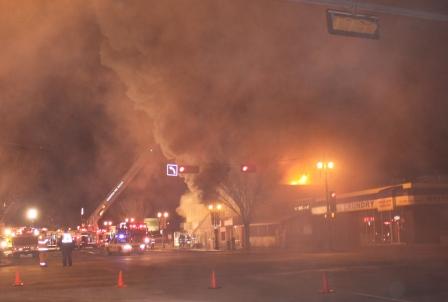Whyte Avenue fire affects local air quality
At 4:00am on April 7, 2011, I woke up to smoke pouring through the vent in my bedroom. Was my building on fire? I stepped outside and saw firefighters in gas masks combating a black cloud less than a hundred paces away. When the stinging eyes and tight chest set in, we took our child and left our neighborhood for the night. Before biking to work in the morning, I made sure to check Alberta Environment’s “real time data” on Current Air Quality. All three monitoring stations in Edmonton showed a rating of “good” at all times throughout the night, including the station closest to my home and workplace. But when I rode out at 8:00am, I knew that I should not breathe hard that day.

You don’t need to be a lawyer or a scientist to protect your lungs from environmental health risks. In the cool days of early spring, one proven concern is “particulate matter”: basically floating crud, often from burning stuff. In the city, much particulate matter has backyard sources: garbage fires, roofing tar, revving hot rods. These are sources that you can see, smell, hear and taste for yourself. Move one block and your walk improves. Call bylaw enforcement and your block improves.
You have a legal right to air quality information, and much of it is posted already. You might ask:
● What is the air quality in my region?
Air quality is often a local issue with local solutions, so you could begin by contacting the monitoring body for your “airshed zone”. If you prefer to analyze data yourself, Alberta Environment’s real time results gets audited and stored in the Clean Air Strategic Alliance data warehouse. April is the start of forest fire season, so you might want to check the BC-Alberta smoke forecasting service.
● What contaminants affects the air quality?
“Criteria Air Contaminants” and related pollutants are listed and explained by Environment Canada.
● Who is emitting these contaminants?
The largest pollution emitters must report their emissions to the National Pollutant Release Inventory. You can search this inventory by facility name or geographic location. To see online maps of the NPRI pollution sources and assessments of facility performance, visit the activists at Emitter.ca.
● How do these contaminants affect human and environmental health?
Health Canada provides information on The Health Effects of Air Pollution. Health Canada is piloting a new Air Quality Health Index, though the current pilot sites are not in Alberta. Alberta Environment tracks provincial air quality trends and assesses the environmental implications of those trends as part of its State of the Environment reporting service.
Which brings us back to the Whyte Avenue fire and backyard emissions: too small, too local, and too fleeting to see on official records, but they impact the state of my environment and perhaps yours. The right to access information helps protect human and environmental health, but it is not the right to an answer. Sometimes the best source of information about your environment is you. Trust your senses.
ABOUT THE ENVIRONMENTAL LAW CENTRE:
The Environmental Law Centre (ELC) has been seeking strong and effective environmental laws since it was founded in 1982. The ELC is dedicated to providing credible, comprehensive and objective legal information regarding natural resources, energy and environmental law, policy and regulation in Alberta. The ELC’s mission is to educate and champion for strong laws and rights so all Albertans can enjoy clean water, clean air and a healthy environment. Our vision is a society where laws secure an environment that sustains current and future generations.
As a charity, the Environmental Law Centre depends on your financial support. Help us to continue to educate and champion for strong environmental laws, through tools such as our blog and all of our other resources, so that all Albertans can enjoy a healthy environment. Your support makes a difference.
Donate online today
